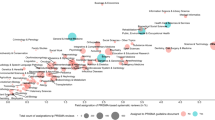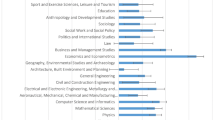Abstract
Journal citation impact factors, which are frequently used as a surrogate measure of research quality, do not correlate well with UK researchers" subjective views of the relative importance of journals as media for communicating important biomedical research results. The correlation varies with the sub-field: it is almost zero in nursing research but is moderate in more “scientific” sub-fields such as multiple sclerosis research, characterised by many authors per paper and appreciable foreign co-authorship. If research evaluation is to be based on journal-specific indicators, then these must cover different aspects of the process whereby research impacts on other researchers and on healthcare improvement.
Similar content being viewed by others
References
Bonitz, M., Journal ranking by selective impact-new method based on SDI results and journal impact factors, Scientometrics, 7 (1985) 471-485.
Banos, J.E., Casanovas, L., Guardiola, E., Bosch, F., Analysis of Spanish biomedical journals by impact factor, Medicina Clinica, 99 (1992) 96-99.
Davis, G., Royle, P., A comparison of Australian university output using journal impact factors, Scientometrics, 35 (1996) 45-58.
Garfield, E., Journal impact factor: a brief review, Canadian Medical Association Journal, 161 (1999) 979-980.
Butler, D., France sets high targets for impact factors and patents, Nature, 394 (1998) 309.
Boor, M., The citation impact factor-another dubious index of journal quality, American Psychologist, 37 (1982) 975-977.
Edwards, R. G., Van Steirtegham, A. C., Richardson, M. J., Impact factors-more misleading than ever, Human Reproduction, 8 (1993) 983-985.
Hansson, S., Impact factor as a misleading tool in evaluation of medical journals, Lancet, 346 (1995) 906.
Moed, H. F., Van Leeuwen, TH. N., Impact factors can mislead, Nature, 381 (1996) 186.
Seglen, P. O., Why the impact factor of journals should not be used for evaluating research, BMJ, 314 (1997) 498-502.
Smith, R., Unscientific practice flourishes in science, BMJ, 316 (1998) 1036.
Moed, H. F., Van Leeuwen, T. N., Reedijk, J., A critical analysis of the journal impact factors of Angewandte Chemie and the Journal of the American Chemical Society-inaccuracies in published impact factors based on overall citations only, Scientometrics, 47 (1996) 105-116.
Van Leeuwen, T. N., Moed, H. F., Reedijk, J., Critical comments on Institute for Scientific Information impact factors-a sample of inorganic molecular chemistry journals, Journal of Information Science, 25 (1999) 489-498.
Lewison, G., The quantity and quality of female researchers: a bibliometric study of Iceland, Scientometrics, 52 (2001) 29-43. See Figure 7, p. 41.
Jacobs, D., Ingwersen, P., A bibliometric study of the publication patterns in the sciences of South African scholars 1981–96, Scientometrics, 47 (2000) 75-93.
Luwel, M., A bibliometric profile of Flemish research in natural, life and technical sciences, Scientometrics, 47 (2000) 281-302.
Nederhof, A. J., Van Wijk, E., Profiling institutes: identifying high research performance and social relevance in the social and behavioural sciences, Scientometrics, 44 (1999) 487-506.
Chi Research Inc., private communication.
Grant, J., Cottrell, R., Cluzeau, F., Fawcett, G., Evaluating “payback” on biomedical research from papers cited in clinical guidelines: applied bibliometric study, BMJ, 320 (2000) 1107-1111.
Anderson, J., Williams, N., Seemungal, D., Narin, F., Olivastro, D., Human genetic technology: exploring the links between science and innovation, Technology Analysis and Strategic Management, 8 (1996) 135-156.
Narin, F., Patent bibliometrics, Scientometrics, 30 (1994) 147-155.
Lewison, G., The definition and calibration of biomedical subfields, Scientometrics, 46 (1999) 529-537.
Dawson, G., Lucocq, B., Cottrell, R., Lewison, G., Mapping the Landscape–National Biomedical Research Outputs 1988–95. Wellcome Trust policy report, 9, (1998) See section A3.8, pp. 58-59.
Lewison, G., Grant, J., Jansen, P., International gastroenterology research: subject areas, impact and funding, Gut, 49 (2001) 295-302. See Figure 2.
Lewison, G., New bibliometric techniques for the evaluation of medical schools, Scientometrics, 41 (1998) 5-16.
Lewison, G., Van Rooyen, S., Reviewers' and editors' perceptions of submitted manuscripts with different numbers of authors, addresses and funding sources, Journal of Information Science, 25 (1999) 509-511.
Martin, B., The use of multiple indicators in the assessment of basic research, Scientometrics, 36 (1996) 343-362.
Author information
Authors and Affiliations
Rights and permissions
About this article
Cite this article
Lewison, G. Researchers" and users" perceptions of the relative standing of biomedical papers in different journals. Scientometrics 53, 229–240 (2002). https://doi.org/10.1023/A:1014804608785
Issue Date:
DOI: https://doi.org/10.1023/A:1014804608785




